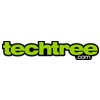-
Team TechTree
14:28 30th Nov, 2018
Top Ten Web Designs in 2018 | TechTree.com
Top Ten Web Designs in 2018
[Sponsored] Web designs keep on changing and every year you find new trends coming in
Website owners and web designers need to keep pace with new developments in web design to ensure functionality, great user experience, and interactions with the site elements. In 2018, new designs ranged from broken grid layouts to fluid effects to typographic animations. Earlier web design trends like clean web designs, minimalist, responsive websites, and flat web designs also featured in 2018. That being said, here are the top ten web designs witnessed in 2018.
1. Rich micro interactions
Use of micro interactions make websites to be interesting and interactive. For example, you can have elements of a site that shake and wave as a user navigates through a page. Micro interactions can be paired with hovering effects and use of white space to bring in a new experience to the user.
2. Full screen video
Websites are using full screen video on the background to help provide more details about a brand. Coordinating background video together with the color schemes and the overall design results in giving a sense of elegance or fashion to the users.
3. Broken grid layouts
Using asymmetry or broken grid layouts helps stimulate the interest of users and encourage website interactions. You can personalize your website using this kind of grid layouts.
4. Fluid effects
To attract and retain website users, fluid effects come in handy. They not only give a site the visual appeal it needs but also help keep users remain glued to the site to find out more. You can use this design element to revamp your UI designs.
5. Combining dynamic texts and photos
Using dynamic texts along with photos makes the user interface to be intuitive. You can even customize the special effects for the texts and photos used in user interface. People love photos and images, so this can be a great way to communicate with your audience through text and images.
6. Organic and oblique shapes
Card based user interfaces have dominated web and mobile designs for many years. In the past the cards featured sharp-edges and right angles but that shifted direction in 2017. Today, tech giants like Google, Facebook, and Twitter pride themselves of having rounded corners on profile avatars, cards, and input boxes.
7. Insidious interactions and animations
A website is more than the aspect of printing words within a page. When designing a website, you not only want to present information, but also make the information move and allow users to interact as well as impact that information. Animations come in handy when it comes to enhancing the website interactions.
8. Use of serifs
In the olden days, it made sense to use sans serif fonts within the user interfaces for websites. This was because of the poor font support and use of non-retina screens. There came a time when things changed and custom fonts where introduced. But serifs seem to be back.
9. Floating navigation menus
In sites that have sprawling menus or are conversion-focused, use of fixed navigation has been common. This simplifies the user experience by ensuring that the navigational controls remain at the fingertips of the user. Floating navigation menus offer a fun way to experience a site.
10. Parallax scrolling design
Using parallax scrolling designs allows you to highlight visual layouts, hierarchy, and important aspects in a website. This design creates a user experience that can be likened with watching a movie. You can scroll through a series of videos by simply scrolling the wheel of the mouse.
Web design elements offer a great way of improving the user experience and website interactions. If for example, you were navigating a website like AvaCare Medical, you want to see design elements that easily allow the user to get the information they need. Use of image and text helps give the user much of the information they need about a product. Different web design elements can be applied differently in websites depending on how you want to present the visual, graphic, textual, and imagery aspects to the audience.
TAGS: Website
- DRIFE Begins Operations in Namma Bengaluru
- Sevenaire launches ‘NEPTUNE’ – 24W Portable Speaker with RGB LED Lights
- Inbase launches ‘Urban Q1 Pro’ TWS Earbuds with Smart Touch control in India
- Airtel announces Rs 6000 cashback on purchase of smartphones from leading brands
- 78% of Indians are saving to spend during the festive season and 72% will splurge on gadgets & electronics
- 5 Tips For Buying A TV This Festive Season
- Facebook launches its largest creator education program in India
- 5 educational tech toys for young and aspiring engineers
- Mid-range smartphones emerge as customer favourites this festive season, reveals Amazon survey
- COLORFUL Launches Onebot M24A1 AIO PC for Professionals







TECHTREE